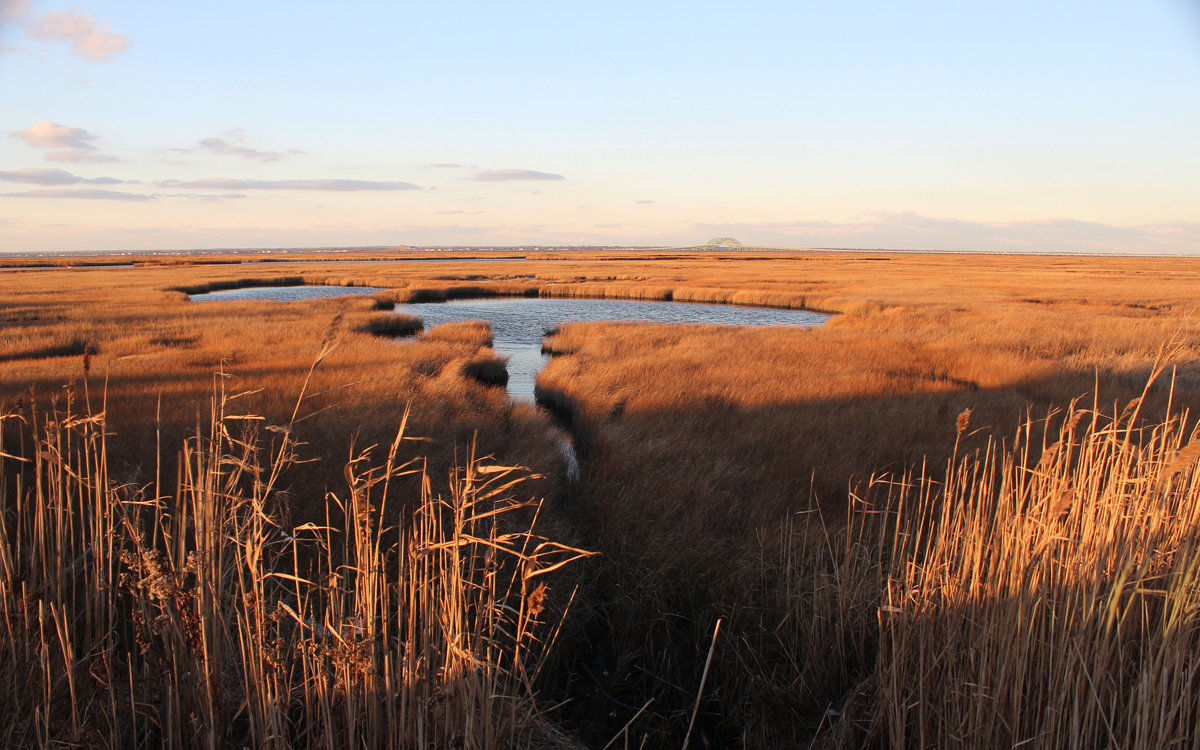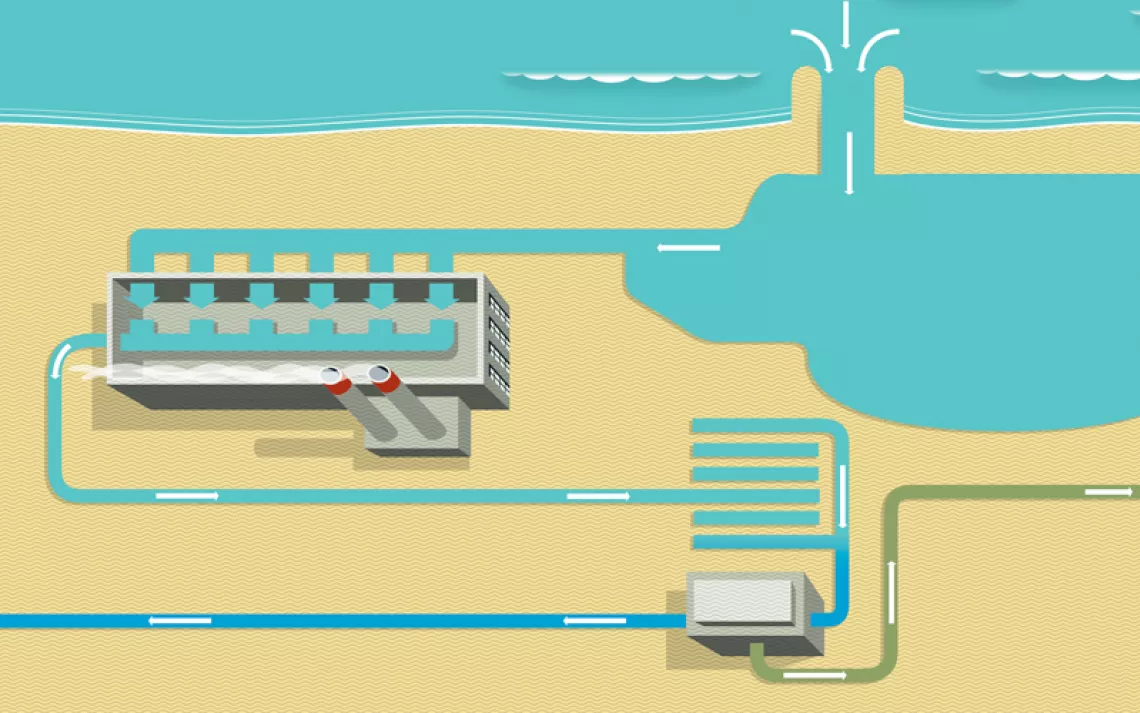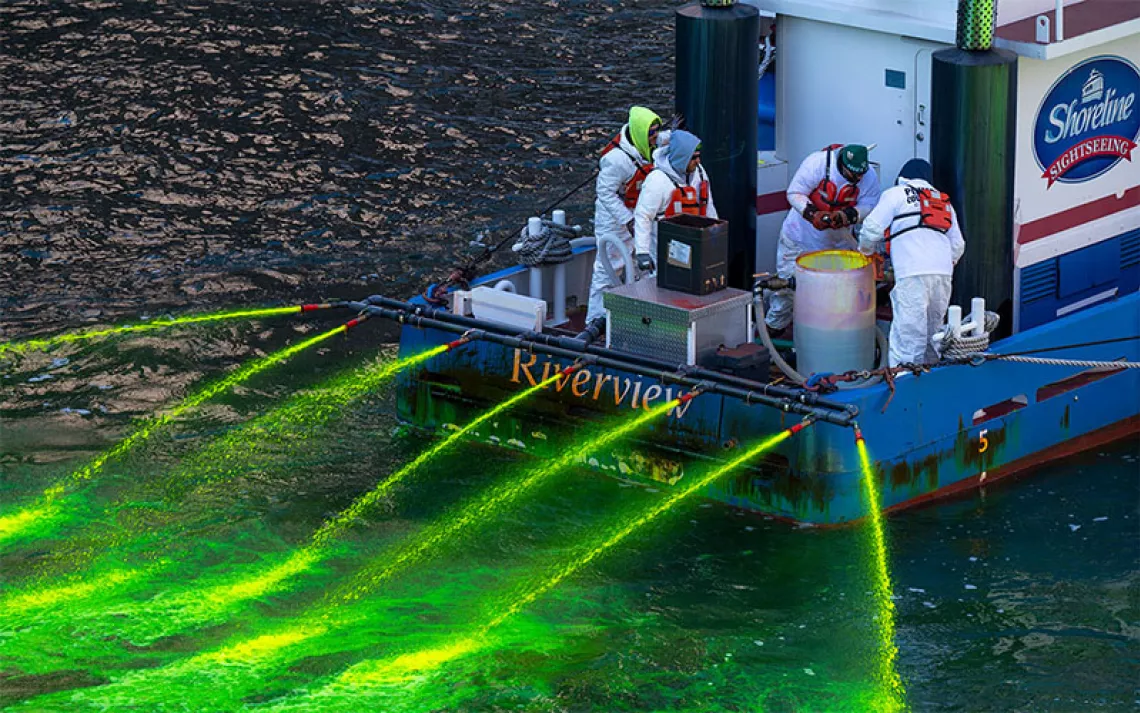So WOTUS Is Legal. Now What?
Fewer strip malls and subdivisions, possibly

Illustration by Ekolara | iStock
Last month, the Obama-era Clean Water Rule—which set out to clarify once and for all that the Clean Water Act also protects seasonal streams, lakes, and wetlands—unexpectedly became the law of the land when a federal district court judge decided that the Trump administration had overstepped its bounds by suspending the rule without taking public comment first.

Captree Island, Long Island, New York | Photo courtesy of Jeanethe Falvey/U.S. EPA
You also only have to look at New York to see why WOTUS’s opponents don’t like the rule. The metropolis of 9 million people gets to drink clean water because the city and state governments routinely block development in the city’s watershed. So the most ardent opponents of WOTUS are groups like the American Petroleum Institute, the American Road and Transportation Builders Association, the National Alliance of Forest Owners, the National Association of Home Builders, the National Cattlemen’s Beef Association, the National Corn Growers Association, the National Mining Association, the National Pork Producers Council, the National Stone, Sand and Gravel Association, and the U.S. Poultry & Egg Association. These business groups also jumped into the lawsuit and took the side of the EPA.
The question is, what’s going to happen to WOTUS—and to seasonal streams and wetlands—now that the Clean Water Rule is in effect. “Overall it's a giant mess,” says Holly Doremus, who teaches environmental law at UC Berkeley. “It’s in effect in some states. It's not in effect in others.” Injunctions granted against the Clean Water Rule by district courts in North Dakota and Georgia means the rule doesn’t apply in 24 states but is now the law in California, Connecticut, Delaware, Hawaii, Illinois, Iowa, Louisiana, Maine, Maryland, Massachusetts, Michigan, Minnesota, Mississippi, New Hampshire, New Jersey, New York, Ohio, Oklahoma, Oregon, Pennsylvania, Rhode Island, Tennessee, Texas, Vermont, Virginia, and Washington.
But several of the aforementioned states are frantically trying to get their own injunctions in place. Texas attorney general Ken Paxton, who is currently suing the Trump administration’s EPA for daring to say San Antonio has too much smog, has already filed a request with a federal court in Texas to expand the injunction to include the Lone Star State. So have Louisiana and Mississippi.
Farmers and ranchers are the most visible opponents of the Clean Water Rule. But, Doremus says, as long as they don’t dump waste directly into a river, farmers and ranchers are already largely exempt from the Clean Water Act. WOTUS won’t affect them much.
The entities most likely to be affected by the Clean Water Rule are oil and gas companies that need permits to build new pipelines, real estate developers, and companies that sell sand, stone, and gravel to anyone interested in replacing an unpredictably soggy landscape with something more conducive to a strip mall.
Which brings us to the WOTUS backstory. The Clean Water Rule at least partly owes its existence to a real estate developer named John Rapanos, who filled several acres of Michigan wetlands with sand in the late 1980s, in the hopes of attracting a shopping mall to build there. When the EPA sued him for not getting a permit first, the ensuing years of litigation over whether Rapanos had violated the Clean Water Act made it clear that the issue of what constituted “water” was contentious enough that the Clean Water Act needed a more precise definition.
So the EPA asked the Obama administration to clarify the Clean Water Act and sent along a letter stating that between 2006 and 2007, regional EPA divisions had backed away from prosecuting 305 cases because they weren’t sure that they could win under the act’s vague definition of which waterways deserved protection. This was particularly true in western states, where the rainfall for the entire year is often concentrated in just a few weeks, and many lakes and streams only flow for a few months.
The rule was based on the opinion written by former Supreme Court justice Anthony Kennedy in the Rapanos case. Kennedy was a conservative, but he had practiced law in California and understood how what looked like a dry ditch in September could be a raging torrent in April. The Trump administration, though, wants to change the rule to be in alliance with another former Supreme Court justice, Antonin Scalia.
“The president directed EPA to issue a new Clean Water jurisdiction rule,” Doremus says, about the early days of the Trump administration. “And he encouraged EPA to issue a rule that would be as narrow about federal jurisdiction as Justice Scalia's concurring opinion in the Rapanos case.” In that 2006 opinion, Scalia ignored hundreds of years of hydrological science and used a copy of Webster’s dictionary to determine what counted as water. (FYI: If Brett Kavanaugh makes it to the Supreme Court, he will almost certainly side with Scalia.) Scalia wrote
The phrase “the waters of the United States” includes only those relatively permanent, standing or continuously flowing bodies of water “forming geographic features” that are described in ordinary parlance as “streams, oceans, rivers, [and] lakes,” Webster’s New International Dictionary 2882 (2d ed.), and does not include channels through which water flows intermittently or ephemerally, or channels that periodically provide drainage for rainfall.
“That will certainly also be challenged in court,” Doremus says. “Many people, including me, believe such a rule would be inconsistent with the Clean Water Act. And so if they issue such a rule it will absolutely be challenged immediately.”
The public comments made when the EPA attempted to cancel WOTUS show that, for many people, the implementation of the Clean Water Rule is long overdue.
“It is important that even dry streams and riverbeds be considered as “waters of the United States” because, as our recent drought has reminded us, seasonality can be within a year or within multiyear cycles,” wrote R. Brett Matzke, environmental director for the Cortina Rancheria Kletsel Dehe Band of Wintun Indians in Williams, California. "We must have the ability to protect drinking water and water that supports aquatic life whenever water returns to those areas.”
“An overarching goal of the Clean Water Act is the restoration and maintenance of chemical, physical, and biological integrity of the nation’s waters,” wrote Tracy Mehan, director of government affairs for the American Water Works Association, a water utility trade organization. “To limit the definition to a strict Scalia interpretation will likely make the achievement of this goal and the implementation of this policy difficult to nearly impossible.”
As climate change continues to make both rainfall and drought more intense across the country, the Clean Water Rule has become about more than clean water. Because it can be used to block construction in seasonal waterways, it can do the work of other disaster-preparedness planning that the Trump administration managed to eliminate, like the Obama-era executive order requiring that buildings and infrastructure built with federal dollars be built to withstand severe floods and designed to use natural ecosystems to minimize flood damage. It will play a critical role in letting nature do work that would otherwise be handled by levees and flood insurance.
That said, if your goal is clean water, the Clean Water Rule was only ever one tool in the toolbox. For example, it’s hard to think of a city more in need of restrictions on wetland development than Houston, which was hit with one of the most expensive floods in U.S. history when Hurricane Harvey came through and illustrated how the prairie slough wetlands around the city of Houston that would have absorbed rainfall a decade ago were entombed in concrete and covered with subdivisions.
But Houston’s wetlands wouldn’t have been recognized as worthy of protection under the Clean Water Rule, says John Jacob, a professor at Texas A&M University and director of the Texas Community Watershed Partners, because the Galveston Army Corps of Engineers has refused to acknowledge nearly half of the freshwater wetlands around Houston as having a “significant nexus” to navigable waters.
After years of presenting the corps with data and studies put together by researchers at Baylor and Texas A&M, Jacob has come to the conclusion that a lawsuit is the only thing that will persuade the corps to think differently. “They tend to be very lawsuit averse,” says Jacob, of the corps. “The developer side has been a little pushier. They're there in front of them all the time. The environmental side is not in their face all the time. That's absolutely part of it.”
“We'll have that argument in front of a judge,” Jacob says. “You have to be very careful how you translate it. If you've got data there and say, ‘This shows the wetlands are connected,’ then the judge hopefully will say, ‘Well, now we all need to get with the program here and regulate those wetlands.’”
In the meantime, Houston recently passed a $2.5 billion bond that will partially go to buy property in some of the worst-flooded areas. But, Jacob says, to really buy out all the houses that developers built in the floodplains would take closer to $20 billion. It would be a $20 billion well spent: At the end of it, Houston’s remaining neighborhoods would be more high-density and walkable, threaded with parkland and wild areas that would absorb rainfall in a flood and provide space for wandering and recreation the rest of the year. “‘We’re in a pickle,’ as they say,” says Jacob. “But we also say, ‘Never let a good flood go to waste.’”
 The Magazine of The Sierra Club
The Magazine of The Sierra Club



